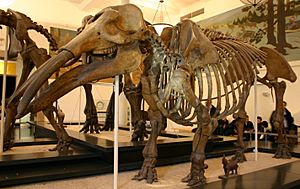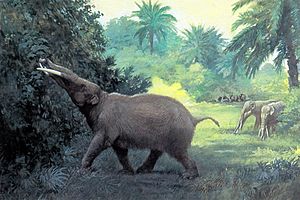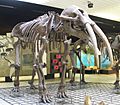Gomphotherium facts for kids
Quick facts for kids Gomphotherium |
|
|---|---|
 |
|
| Gomphotherium productum at the AMNH | |
| Scientific classification | |
| Kingdom: | |
| Class: | |
| Order: | |
| Family: | |
| Genus: |
†Gomphotherium
Burmeister, 1837
|
| Synonyms | |
|
|
Imagine an ancient relative of today's elephants! That's Gomphotherium, a fascinating animal that lived long, long ago. It was a type of proboscid, which is the group of mammals that includes elephants. Gomphotherium first appeared in North America during the early Miocene epoch, a time period that started about 23 million years ago.

These amazing creatures lived for a very long time, from about 13.65 million years ago until about 1.7 million years ago. They spread out from North America to Asia, Europe, and Africa. This happened when sea levels dropped, making it easier for them to cross land bridges. Their fossils have been found in many places, including Chile, China, France, Germany, Pakistan, and Kenya.
What was Gomphotherium like?
Gomphotherium was a large animal, standing about 3 meters (10 feet) tall. It weighed around 4 to 5 tons, which is similar to a modern elephant. However, there was one big difference: Gomphotherium had four tusks! It had two tusks on its upper jaw and two more on its long lower jaw.
Its Amazing Tusks
The lower tusks of Gomphotherium were straight and flat, almost like a shovel. Scientists think these tusks might have been used to dig up food from soft mud or swampy areas. These animals probably lived near lakes or in wet, wooded regions, using their tusks to scoop up water plants.
Unlike modern elephants, the upper tusks of Gomphotherium were covered in a layer of enamel, which is the hard, shiny coating on teeth.
How it Ate
Scientists have studied the teeth of Gomphotherium's relatives, like Platybelodon. They found wear patterns that suggest these animals used their lower tusks to strip bark from trees. They might have used the sharp edges of their "shovel" tusks like a scythe. They could grab branches with their trunk and rub them against their lower teeth to cut them off the tree.
Compared to modern elephants, Gomphotherium had a longer, lower skull. This suggests it had a shorter trunk, perhaps more like a tapir'''s trunk. Gomphotherium also had fewer molar teeth than earlier proboscids. However, the molars it did have were very effective. They had high ridges that made their grinding surface larger, helping them chew their food well.
Images for kids
See also
 In Spanish: Gomphotherium para niños
In Spanish: Gomphotherium para niños




